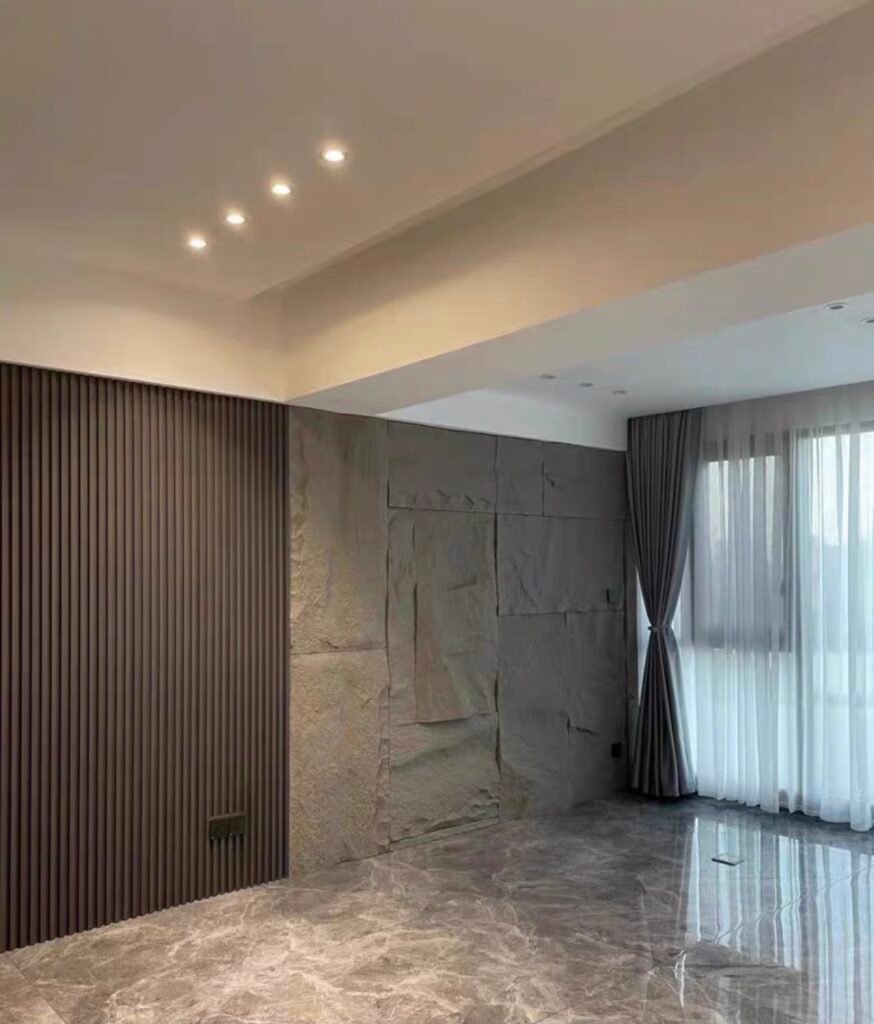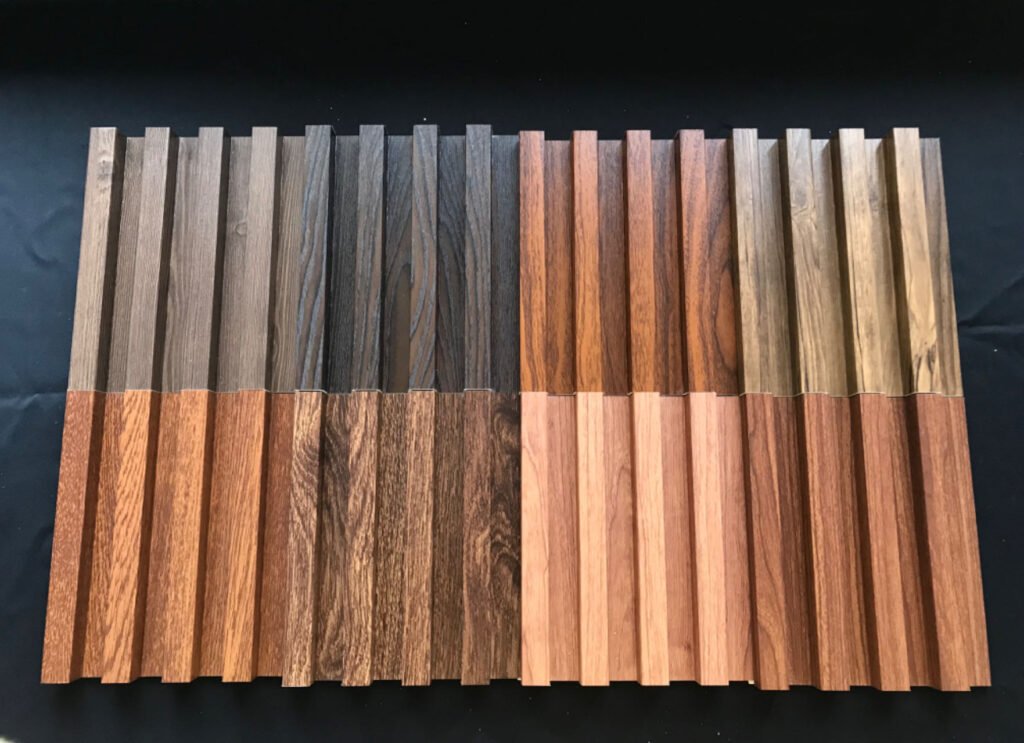When it comes to creating stylish and functional interiors, the materials you choose can make all the difference. One of the most innovative and popular options today is Wood Plastic Composite (WPC) panels. These panels combine the best of both wood and plastic, offering a range of benefits that make them an ideal choice for modern interior design.
What Are WPC Panels?
WPC panels are made from a blend of wood fibers and plastic (polymer resins). They provide the look of wood, but with the enhanced durability and moisture resistance of plastic. This makes them the perfect solution for a variety of interior applications, from residential living rooms to high-traffic commercial spaces.
Benefits of Using WPC Panels for Interior Spaces
1. Eco-Friendly and Sustainable
WPC panels are made from recycled materials, helping to reduce waste and conserve natural resources. By choosing WPC panels, you’re making a sustainable choice for your home or business.
2. Durability and Low Maintenance
Unlike traditional wood or natural stone, WPC panels are resistant to moisture, scratches, and fading, making them ideal for high-traffic areas like hallways, kitchens, and offices.
3. Versatile Design Options
Available in a wide variety of finishes, WPC panels mimic the look of natural wood, stone, or even marble, giving you the flexibility to choose the perfect style for your space. Whether you’re looking for a minimalist look or something more luxurious, there’s a WPC panel design that fits your needs.
4. Easy Installation
Installing WPC panels is quick and straightforward, with minimal tools required. Whether you’re a DIY enthusiast or working with a professional contractor, you’ll appreciate the effortless installation process.
Popular Applications of WPC Panels in Interior Design
From creating accent walls in the living room to updating the office or even transforming the bathroom with sleek, moisture-resistant panels, WPC panels can be used in a wide range of interior settings. Their versatility makes them ideal for residential and commercial projects alike.
Wall Panels: Show how WPC panels can be used for accent walls, feature walls, and decorative partitions, especially in living rooms, bedrooms, and offices.
Ceiling Panels: Mention their use for creating modern ceilings in both residential and commercial spaces.
Interior Cladding: Highlight their role in interior cladding for a seamless, stylish look in lobbies, corridors, and reception areas.
Furniture and Paneling: Discuss how WPC panels can be used for furniture surfaces like cabinets, doors, and even countertops.

Why Choose WPC Panels Over Traditional Materials?
When it comes to designing or renovating your home or commercial space, the materials you choose can significantly impact both the aesthetic and the long-term durability of your project. While traditional materials like wood, stone, and ceramic tiles have their own merits, Wood Plastic Composite (WPC) panels are quickly becoming a preferred alternative. Here’s why you should consider choosing WPC panels over traditional materials:
1. Durability and Longevity
WPC Panels are engineered to withstand the rigors of everyday use far better than traditional materials like wood or stone.
- Moisture Resistance: Unlike wood, which is prone to warping, rotting, and swelling due to moisture, WPC panels are water-resistant and can be used in high-moisture areas like bathrooms, kitchens, and even exterior facades.
- Scratch and Impact Resistance: WPC panels are significantly more resistant to scratches, dents, and impacts than natural wood or stone. While wood can get scratched over time, and stone can chip or crack, WPC panels retain their appearance longer without the need for frequent repairs.
- UV and Weather Resistance: When used outdoors, traditional materials like wood tend to fade, discolor, or deteriorate under UV exposure. WPC panels, on the other hand, are UV-stable, meaning they retain their color and appearance even under harsh sun exposure, making them ideal for outdoor applications such as decking and facades.
2. Cost-Effectiveness
- Lower Material and Labor Costs: While natural wood or stone can be expensive, both in terms of material costs and installation, WPC panels are often more affordable. WPC panels offer cost savings not only in terms of initial investment but also over time due to their low-maintenance requirements.
- No Need for Regular Maintenance: Traditional materials like wood require regular staining, sealing, or polishing, while WPC panels require little to no maintenance. Wood also requires frequent treatment to protect against moisture, pests, and decay. This significantly reduces long-term maintenance costs.
3. Eco-Friendly and Sustainable
WPC panels are made from a combination of recycled wood fibers and plastics, which helps reduce waste and conserve natural resources. In contrast, the production of traditional materials like wood, stone, or marble can lead to deforestation, environmental degradation, and excessive energy consumption.
- Sustainability: Choosing WPC panels supports sustainable building practices. By opting for recycled materials, you are helping to reduce your environmental footprint and contribute to a more eco-friendly building industry.
- Non-toxic and Safe: Many WPC panels are non-toxic and free of harmful chemicals, making them a safer choice for indoor air quality compared to materials like treated wood that may off-gas formaldehyde or other volatile organic compounds (VOCs).
4. Versatility in Design
One of the most significant advantages of WPC panels is their versatility. Traditional materials like wood and stone can limit your design options, especially in terms of finish, texture, and color. However, WPC panels are available in a wide range of styles, textures, and colors that mimic natural materials, such as:
- Wood Grain: WPC panels can replicate the beautiful grain patterns of hardwood, giving you the look of natural wood without the associated upkeep.
- Stone Finishes: WPC panels can also replicate the appearance of natural stone or marble, offering luxury finishes at a fraction of the cost.
- Modern & Minimalist Styles: With smooth, sleek surfaces and matte or glossy finishes, WPC panels cater to modern and contemporary designs, making them suitable for interior and exterior applications.
5. Easy Installation
- Lightweight: WPC panels are much lighter than traditional materials like stone or even solid wood. This makes them easier to transport and install, saving both time and labor costs.
- User-Friendly Installation: Many WPC panels come with clip-on or adhesive systems that make installation even simpler. With minimal tools required, DIY enthusiasts can install WPC panels with ease, unlike wood or stone, which may require professional help.
6. Low Maintenance and Easy to Clean
Unlike traditional materials such as wood or stone, which require regular care, WPC panels are highly low-maintenance.
- Resistant to Mold and Mildew: Due to their moisture resistance, WPC panels do not absorb water, preventing mold and mildew buildup. This is especially beneficial in high-humidity environments.
- Simple Cleaning: WPC panels are easy to clean and maintain. Unlike stone surfaces that may need sealing or scrubbing, or wood that may require oiling and sanding, WPC panels simply need a wipe-down with mild soap and water to maintain their look.
7. Fire Resistance
WPC panels have a fire-retardant nature, which makes them safer compared to traditional wood panels, which are highly flammable. This feature is particularly useful in commercial spaces or buildings where fire safety standards are strict.
8. Enhanced Aesthetic Flexibility
- Seamless Look: With WPC panels, you can achieve a seamless look for both interior and exterior spaces. Unlike natural wood or stone, which can have visible joints or seams, WPC panels provide a smooth, uniform surface.
- Customization: WPC panels can be easily customized to fit a variety of design themes, from rustic to contemporary, offering more design flexibility compared to traditional materials that may be limited in color or pattern.
What facts does buyers/importers/brand company care about before order WPC interior panel from china?
When buyers, importers, or brand companies are considering ordering WPC (Wood Plastic Composite) interior panels from China, there are several key factors they evaluate before making a purchase. These factors help ensure that they receive high-quality products at competitive prices while minimizing risks and ensuring that the products meet both aesthetic and functional requirements. Below are the most important considerations:
1. Quality and Durability
- Material Composition: Buyers will want to know the exact composition of the WPC panels, including the type and percentage of wood fibers and plastic used. Higher-quality products typically use better quality wood fibers and more durable plastics.
- Resistance to Moisture: WPC panels should be water-resistant and moisture-resistant, making them suitable for high-humidity areas like kitchens and bathrooms. Buyers often ask for performance data related to moisture resistance and swelling rates.
- Scratch, Impact, and UV Resistance: The durability of the surface finish (e.g., gloss, matte, or textured) and the panel’s resistance to scratches, impacts, and UV degradation are important for buyers who expect long-lasting products.
- Fire Resistance: Many markets have strict fire-safety regulations, so buyers will inquire about the fire-resistance rating of the panels.
2. Product Certifications and Standards
- International Certifications: Importers often seek ISO certification, CE certification, and other internationally recognized quality standards to ensure that the products meet required performance and safety standards.
- Environmental Certifications: Certifications like FSC (Forest Stewardship Council), Green Building Council certifications, and environmental labels are important for buyers who prioritize sustainable sourcing and eco-friendly materials.
- Compliance with Local Standards: Some countries have specific regulations for materials used in construction. Buyers will want to know if the WPC panels comply with local standards for materials in construction or interior applications.
3. Cost and Price Competitiveness
- Competitive Pricing: Buyers are always looking for cost-effective solutions. They will compare prices from different suppliers in China, keeping in mind both unit price and shipping costs.
- Volume Discounts: Buyers who plan to place large orders often inquire about bulk purchase discounts or pricing based on order volume.
- Payment Terms and Conditions: Payment flexibility is important. Importers typically prefer clear payment terms such as 30% deposit and 70% balance before shipment, and they may negotiate payment methods (e.g., letter of credit, T/T).
4. Customization and Design Options
- Tailored Sizes and Colors: Importers and brand companies will often seek customized panel sizes, colors, and textures to meet the unique demands of their projects or target market.
- Design Flexibility: Buyers may want options for custom patterns, textures (e.g., wood grain, stone, or marble effects), and special finishes to ensure the WPC panels align with design trends in their local market.
- Branding and Labeling: Companies looking to create a unique identity will ask for options to include their own logos, labels, and branded packaging.
5. Supply Chain and Lead Time
- Production Lead Time: Buyers will want to know the manufacturing timeline from the moment they place an order until the products are ready to ship. Shorter lead times are preferred, especially for businesses with fast turnaround needs.
- Minimum Order Quantity (MOQ): The MOQ is a key consideration, especially for smaller importers or brands. They will want to ensure that the MOQ fits their budget and project requirements.
- Shipping and Delivery Time: Delivery timelines are critical for timely project completion. Buyers will check for reliable shipping schedules and inquire about the average time to ship products from China to their destination, especially in light of customs processing.
6. Supplier Reputation and Reviews
- Company Reputation: Importers typically research the reputation of the manufacturer or supplier. They look for positive reviews, long-term business relationships, and proof of reliability in fulfilling large-scale orders.
- Experience in Exporting: Experienced suppliers who regularly export to the buyer’s region or country are preferred. They understand international shipping, customs regulations, and can provide clear documentation for customs clearance.
- Previous Client Testimonials: Importers may request case studies or testimonials from other clients who have used the supplier’s WPC panels to ensure product reliability and customer satisfaction.
7. Technical Support and Customer Service
- After-Sales Support: Buyers often prioritize suppliers that provide solid after-sales support, such as installation assistance, warranty information, and technical consultations to address any potential issues after the product is received.
- Installation Guidance: Buyers may inquire whether the supplier provides installation guides or videos, or if they have an installation team available for larger projects.
8. Sustainability and Eco-Friendliness
- Recycled Materials: Increasingly, buyers are looking for WPC panels made from recycled plastic and wood fibers to reduce their environmental footprint.
- Low-VOC and Non-toxic: Products that are non-toxic and low in volatile organic compounds (VOCs) are increasingly in demand, especially for interior applications in homes, offices, and schools.
- Sustainable Manufacturing Practices: Buyers may inquire about the sustainability of the manufacturing process, such as energy-efficient production methods or waste reduction strategies.
9. Samples and Product Testing
- Product Samples: Buyers typically request product samples before committing to large orders to ensure the quality and design meet their expectations.
- Product Testing: Some buyers may request specific tests (e.g., moisture absorption, scratch resistance, fire testing, formaldehyde emission tests) to verify the product’s durability and safety.
10. Shipping and Customs Considerations
- Customs Documentation: Importers will want to ensure that the supplier provides all necessary documentation for customs clearance, including Certificates of Origin, Bills of Lading, and Packing Lists.
- Shipping Terms: Familiarity with Incoterms (e.g., FOB, CIF, EXW) is crucial for importers, as it determines who handles shipping and at what cost.
- Packaging: Packaging must be strong enough to protect the WPC panels during long transit times, especially for delicate or decorative finishes. Buyers will inquire about packaging options to ensure their products arrive in pristine condition.
11. Market and Product Trends
- Consumer Preferences: Buyers may ask for market insights to ensure the designs and features of the WPC panels align with current interior design trends in their region.
- Innovative Products: Importers are increasingly interested in the latest innovations in WPC panel technology, such as anti-bacterial coatings, self-cleaning surfaces, or eco-friendly materials that meet consumer demand for green products.
Before placing an order for WPC interior panels from China, buyers and importers assess a range of factors, including quality, cost, design options, supply chain logistics, and environmental impact. Ensuring that the supplier meets their specific requirements in these areas will help mitigate risks and ensure a successful, long-term business relationship.
By addressing these key considerations, HiNiDeco and similar companies can build trust with buyers and offer a value proposition that resonates with both commercial and individual customers.




